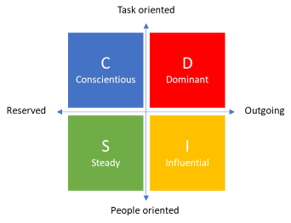If you are new to the idea of Team Praxis, please read our introduction to the concept before using the table below to improve your communications with team members, stakeholders and anyone else involved in your project, programme or portfolio.
The goals of management plans used in governance are to:
- describe the principles that should be used to manage the work;
- provide consistency with flexibility across multiple projects and programmes.
The goals of delivery planning are to:
- describe the objectives of the project, programme or portfolio;
- define the work required to achieve the objectives and describe how it will be performed;
- estimate the resources and finance needed to perform the work;
- document the plans and update them throughout the life cycle.
When implementing these goals people with different character traits would perceive plans and planning techniques in different ways.
 Concientious behaviour would typically propose or want to see: Concientious behaviour would typically propose or want to see:
-
a full set of management plans that provide defined practices and clear responsibilities for all those involved in delivery; -
a clear and objective explanation of what planning is to achieve with a bias towards consistency rather than flexibility; -
a consistent and systematic approach that clearly links objectives to the work necessary to achieve them; -
a rigorous systematic approach to accurate estimating including a high level of contingency; -
sufficient resources committed and time allowed for planning and research; -
delivery plans that are comprehensive, detailed, logical and are regularly reviewed. Someone exhibiting concientious behaviour would typically be perceived as: -
requiring a formalised, comprehensive and rigorous approach to planning; -
seeking perfection through taking their time to carry out detailed planning or taking an iterative approach to reduce uncertainty; -
happier to be working on their own when planning or solving problems. |  Dominant behaviour would typically propose or want to see: Dominant behaviour would typically propose or want to see:
-
the minimum set of succinct management plans necessary to ensure that people understand and accept their responsibilities; -
a clear and objective explanation of what planning is aiming to achieve with a bias towards flexibility rather than consistency; -
an efficient and quick means of planning with the focus being on doing rather than thinking about it; -
planning that provides the maximum freedom of action for those who are responsible for delivery; -
estimates that are sufficiently accurate for the stage in the lifecycle, have minimal contingency and which are sufficient to allow decisions to be made and progress maintained; -
delivery plans that provide the minimum level of detail necessary to allow delivery to progress. Someone exhibiting dominant behaviour would typically be perceived as: -
wishing to minimise the effort on planning and maximise it on delivery and to be in control of the process; -
a decisive decision maker who will be happy accept uncertainty and work through problems in a pragmatic manner; -
challenging plans and seeking ways to deliver more efficiently and quickly. |
 Steady behaviour would typically propose or want to see: Steady behaviour would typically propose or want to see:
-
management plans that involve and meet the needs of users, which are openly referred to and discussed; -
an explanation of what planning is aiming to achieve with a bias towards consistency rather than flexibility; -
sufficient time being allowed for effective planning to be undertaken; -
key individuals engaged in planning and clearly identified roles agreed in advance; -
estimates that are reliable and developed over time with input from key individuals; -
delivery plans that are sufficiently detailed and communicated to key stakeholders. Someone exhibiting steady behaviour would typically be perceived as: -
a competent, patient and enthusiastic planner who is considerate of the resources needed to plan well; -
co-operative, easy to approach and supportive around the process of planning and happy to help others; -
willing to commit their own time to creating robust plans to help reduce uncertainty. |  Influential behaviour would typically propose or want to see: Influential behaviour would typically propose or want to see:
-
management plans that have been developed and agreed collaboratively, can be easily applied and are modified to meet changing needs; -
an explanation of what planning is aiming to achieve with a bias towards flexibility rather than consistency; -
a planning process that actively involves people possibly within a workshop or similar approach; -
early interaction within the team with stakeholders to get their input and look at different options; -
estimates that may be based on gut feel initially and will be validated later during the planning process as data becomes available; -
delivery plans that are sufficiently detailed to allow the team to deliver and that provide a broad understanding of the context within which the work is being undertaken. Someone exhibiting influential behaviour would typically be perceived as: -
informal and collaborative and willing to be actively involved with others during the planning process; -
an ideas generator who would look for alternatives during the planning process; -
comfortable with a high level of uncertainty during the process and in the plans themselves. |
Thanks to Donnie MacNicol of Team Animation for providing this page.


 Concientious behaviour would typically propose or want to see:
Concientious behaviour would typically propose or want to see: Dominant behaviour would typically propose or want to see:
Dominant behaviour would typically propose or want to see: Steady behaviour would typically propose or want to see:
Steady behaviour would typically propose or want to see: Influential behaviour would typically propose or want to see:
Influential behaviour would typically propose or want to see:



